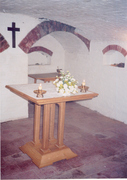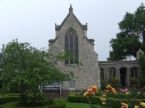The Seed of the Church: Walsingham
The Nicholas Mileham Chapel at Walsingham
In 2004 a new Ecumenical Chapel of Reparation was established in the cellar beneath the former Sue Ryder Foundation building at Walsingham. 360 years before, it had been the prison cell in which Fr Nicholas Mileham, last sub-prior of Walsingham, and a layman, Thomas Guisborough, were held on the night before their martyrdom for the Unity of the Church at Walsingham's Martyrs' Field.
The altar was commissioned by the Catholic League, an ecumenical society supporting the Catholic ecumenical movement (and no connection with the recently established US pressure group of the same name), in honour of the martyrs and Mary, Mother of the Church, and in memory of Geoffrey Wright, a long serving General Secretary who worked painstakingly and tirelessly for spiritual understanding between Anglicans and Roman Catholics throughout his life. Both Anglicans and Roman Catholics have celebrated the Eucharist there to recall the martyrdom and suffering of the brave Christians of the past and to make it fruitful for the Unity, healing and reconciliation of the Christians of the present day.
It is no coincidence that Nicholas Mileham's Cell, now an Ecumenical Chapel of Reparation, is at the heart of England's Nazareth, that once more in the twentieth century became a thriving centre of devotion to Mary, as Mother of Jesus, for Anglicans, Roman Catholics, Orthodox and Protestants alike. Walsingham has honestly faced the scandal of Christian separations and is committed to working towards unity with Mary who brings all Christians to her Son.
The Chapel is not far from the Anglican Shrine, with its Holy House and the Holy Well. Nearby is the new Roman Catholic parish church of the Annunciation, and a little further away are the Orthodox Church and the Anglican parish church of St Mary and All Saints. Opposite are the ruins of the Priory, scene of the great national pilgrimages and beside the Methodist Church in which John Wesley called eighteenth century villagers to renewed faith in Christ stand the remains of the Franciscan friary. A mile away is the medieval Slipper Chapel, the Roman Catholic shrine of Our Lady, with its modern Chapel of Reconciliation, witnessing to the Oneness of the Church and the force for convergence upon Christ that is offered by the Mother of Christ.
The Ecumenical Chapel of Reparation complements all these centres of modern Christianity by concentrating on the special task of making up for the destruction and bloodshed of the past, hallowing the remains of broken Christianity, purifying the memories behind its separate traditions, lamenting the perpetuated continued divisions and channelling contemporary prayer and the Eucharist in honour of the Martyrs towards repentance, healing and reconciliation. These are surely among the 'concrete acts' which Pope Benedict called for at his inauguration.
While the former Sue Ryder building is being refurbished the Martyrs' Chapel unfortunately has to be closed. It is hoped that it will once again be open as a place of prayer for unity later in 2008 or 2009.



